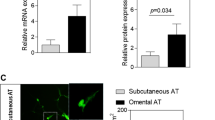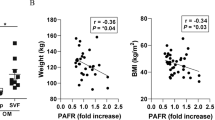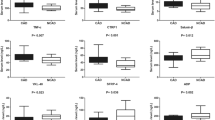Abstract
Background/Aims:
Impaired angiogenesis is linked to adipose tissue (AT) dysfunction, inflammation, and insulin resistance in human obesity. Chemokine (C-X-C motif) receptor. (CXCR3) ligands are important regulators of angiogenesis in different disease contexts such as cancer; however, their role in human morbid obesity is unknown. We investigated the role of the CXCR3 axis in AT angiogenesis in morbidly obese patients.
Subjects/Methods:
The study group comprised 50 morbidly obese patients (mean age 44 ± 1 years, body mass index 44 ± 1 kg/m2) who had undergone laparoscopic Roux-Y-gastric bypass surgery, and 25 age-matched non-obese control subjects. We measured the circulating levels of the CXCR3 ligands monokine induced by interferon-γ (MIG/CXCL9), interferon-γ inducible protein 10 (IP-10/CXCL10), and interferon-γ–inducible T-cell alpha chemoattractant (I-TAC/CXCL11) in all studied subjects. Additionally, the expression of CXCR3 ligands was analyzed in paired biopsies of subcutaneous and visceral AT obtained during the laparoscopic procedure in morbidly obese patients. Additionally, we explored the functional role of CXCR3 ligands on angiogenesis in AT from morbidly obese patients using an ex vivo assay.
Results:
Plasma levels of CXCL10 and CXCL11 were significantly higher in morbidly obese patients than in controls (p < 0.01). In ex vivo assays, angiogenic growth was markedly lower in visceral AT than in subcutaneous AT (p < 0.05), which was related to significant tissue upregulation of CXCL10, CXCL11 and CXCR3 (p < 0.05). CXCL10 or CXCL11 inhibited AT angiogenesis (p < 0.05), and blockade of CXCR3 function significantly increased capillary sprouting in visceral fat deposits (p < 0.05). Western blot analysis showed that the p38 mitogen-activated protein kinase signaling pathway was implicated in the angiostatic effects of CXCR3 in AT.
Conclusions:
CXCL10 and CXCL11 may play. deleterious role in obesity as potential inhibitors of AT angiogenesis. Accordingly, pharmacological blockade of CXCR3 could represent. therapy to prevent AT dysfunction in obesity.
This is a preview of subscription content, access via your institution
Access options
Subscribe to this journal
Receive 12 print issues and online access
$259.00 per year
only $21.58 per issue
Buy this article
- Purchase on Springer Link
- Instant access to full article PDF
Prices may be subject to local taxes which are calculated during checkout






Similar content being viewed by others
References
Wang YC, McPherson K, Marsh T, Gortmaker SL, Brown M. Health and economic burden of the projected obesity trends in the USA and the UK. Lancet. 2011;378:815–25.
Stevens GA, Singh GM, Lu Y, Danaei G, Lin JK, Finucane MM, et al. National, regional, and global trends in adult overweight and obesity prevalences. Popul Health Metr. 2012;10:22.
Hajer GR, van Haeften TW, Visseren FL. Adipose tissue dysfunction in obesity, diabetes, and vascular diseases. Eur Heart J. 2008;29:2959–71.
Booth A, Magnuson A, Foster M. Detrimental and protective fat: body fat distribution and its relation to metabolic disease. Horm Mol Biol Clin Investig. 2014;17:13–27.
Mathieu P, Boulanger MC, Despres JP. Ectopic visceral fat:. clinical and molecular perspective on the cardiometabolic risk. Rev Endocr Metab Disord. 2014;15:289–98.
Cao Y. Angiogenesis and vascular functions in modulation of obesity, adipose metabolism, and insulin sensitivity. Cell Metab. 2013;18:478–89.
Cao Y. Angiogenesis modulates adipogenesis and obesity.. Clin Invest. 2007;117:2362–8.
Xu H, Barnes GT, Yang Q, Tan G, Yang D, Chou CJ, et al. Chronic inflammation in fat plays. crucial role in the development of obesity-related insulin resistance.. Clin Invest. 2003;112:1821–30.
Sung HK, Doh KO, Son JE, Park JG, Bae Y, Choi S, et al. Adipose vascular endothelial growth factor regulates metabolic homeostasis through angiogenesis. Cell Metab. 2013;17:61–72.
Garcia-Martin R, Alexaki VI, Qin N, Rubin de Celis MF, Economopoulou M, Ziogas A, et al. Adipocyte-specific hypoxia-inducible factor 2alpha deficiency exacerbates obesity-induced brown adipose tissue dysfunction and metabolic dysregulation. Mol Cell Biol. 2015;36:376–93.
Pasarica M, Sereda OR, Redman LM, Albarado DC, Hymel DT, Roan LE, et al. Reduced adipose tissue oxygenation in human obesity: evidence for rarefaction, macrophage chemotaxis, and inflammation without an angiogenic response. Diabetes. 2009;58:718–25.
Gealekman O, Guseva N, Hartigan C, Apotheker S, Gorgoglione M, Gurav K, et al. Depot-specific differences and insufficient subcutaneous adipose tissue angiogenesis in human obesity. Circulation. 2011;123:186–94.
Ngo DT, Farb MG, Kikuchi R, Karki S, Tiwari S, Bigornia SJ, et al. Antiangiogenic actions of vascular endothelial growth factor-A165b, an inhibitory isoform of vascular endothelial growth factor-A, in human obesity. Circulation. 2014;130:1072–80.
Strieter RM, Burdick MD, Gomperts BN, Belperio JA, Keane MP. CXC chemokines in angiogenesis. Cytokine Growth Factor Rev. 2005;16:593–609.
Altara R, Manca M, Brandao RD, Zeidan A, Booz GW, Zouein FA. Emerging importance of chemokine receptor CXCR3 and its ligands in cardiovascular diseases. Biofactors. 2016;130:463–78.
Youn JC, Yu HT, Lim BJ, Koh MJ, Lee J, Chang DY, et al. Immunosenescent CD8+T cells and C-X-C chemokine receptor type. chemokines are increased in human hypertension. Hypertension. 2013;62:126–33.
Altara R, Gu YM, Struijker-Boudier HA, Thijs L, Staessen JA, Blankesteijn WM. Left ventricular dysfunction and CXCR3 ligands in hypertension: from animal experiments to. population-based pilot study. PLoS ONE. 2015;10:e0141394.
Altara R, Manca M, Hessel MH, Gu Y, van Vark LC, Akkerhuis KM, et al. CXCL10 is. circulating inflammatory marker in patients with advanced heart failure:. pilot study.. Cardiovasc Transl Res. 2016;9:302–14.
Keeley EC, Moorman JR, Liu L, Gimple LW, Lipson LC, Ragosta M, et al. Plasma chemokine levels are associated with the presence and extent of angiographic coronary collaterals in chronic ischemic heart disease. PLoS ONE. 2011;6:e21174.
Falk MK, Singh A, Faber C, Nissen MH, Hviid T, Sorensen TL. Dysregulation of CXCR3 expression on peripheral blood leukocytes in patients with neovascular age-related macular degeneration. Invest Ophthalmol Vis Sci. 2014;55:4050–6.
Li Y, Reader JC, Ma X, Kundu N, Kochel T, Fulton AM. Divergent roles of CXCR3 isoforms in promoting cancer stem-like cell survival and metastasis. Breast Cancer Res Treat. 2015;149:403–15.
Shen D, Cao X. Potential role of CXCR3 in proliferation and invasion of prostate cancer cells. Int. Clin Exp Pathol. 2015;8:8091–8.
Pedro T, Martinez-Hervas S, Tormo C, Garcia-Garcia AB, Saez-Tormo G, Ascaso JF, et al. Oxidative stress and antioxidant enzyme values in lymphomonocytes after an oral unsaturated fat load test in familial hypercholesterolemic subjects. Transl Res. 2013;161:50–56.
Martorell S, Hueso L, Gonzalez-Navarro H, Collado A, Sanz MJ, Piqueras L. Vitamin. receptor activation reduces angiotensin-II-induced dissecting abdominal aortic aneurysm in apolipoprotein E-knockout mice. Arterioscler Thromb Vasc Biol. 2016;36:1587–97.
Bradford MM.. rapid and sensitive method for the quantitation of microgram quantities of protein utilizing the principle of protein-dye binding. Anal Biochem. 1976;72:248–54.
Petrai I, Rombouts K, Lasagni L, Annunziato F, Cosmi L, Romanelli RG, et al. Activation of p38(MAPK) mediates the angiostatic effect of the chemokine receptor CXCR3-B. Int. Biochem Cell Biol. 2008;40:1764–74.
Ye J. Emerging role of adipose tissue hypoxia in obesity and insulin resistance. Int. Obes. 2009;33:54–66.
Goossens GH, Bizzarri A, Venteclef N, Essers Y, Cleutjens JP, Konings E, et al. Increased adipose tissue oxygen tension in obese compared with lean men is accompanied by insulin resistance, impaired adipose tissue capillarization, and inflammation. Circulation. 2011;124:67–76.
Pasarica M, Rood J, Ravussin E, Schwarz JM, Smith SR, Redman LM. Reduced oxygenation in human obese adipose tissue is associated with impaired insulin suppression of lipolysis.. Clin Endocrinol Metab. 2010;95:4052–5.
Elias I, Franckhauser S, Ferre T, Vila L, Tafuro S, Munoz S, et al. Adipose tissue overexpression of vascular endothelial growth factor protects against diet-induced obesity and insulin resistance. Diabetes. 2012;61:1801–13.
An, YA, Sun, K, Joffin, N, Zhang,. & Deng, Y. Angiopoietin-2 in white adipose tissue improves metabolic homeostasis through enhanced angiogenesis. Elife 2017; 6:e24071.
Deiuliis JA, Oghumu S, Duggineni D, Zhong J, Rutsky J, Banerjee A, et al. CXCR3 modulates obesity-induced visceral adipose inflammation and systemic insulin resistance. Obesity. 2014;22:1264–74.
Schulthess FT, Paroni F, Sauter NS, Shu L, Ribaux P, Haataja L, et al. CXCL10 impairs beta cell function and viability in diabetes through TLR4 signaling. Cell Metab. 2009;9:125–39.
Burke SJ, Karlstad MD, Eder AE, Regal KM, Lu D, Burk DH, et al. Pancreatic beta-Cell production of CXCR3 ligands precedes diabetes onset. Biofactors. 2016;42:703–15.
Rocha VZ, Folco EJ, Ozdemir C, Sheikine Y, Christen T, Sukhova GK, et al. CXCR3 controls T-cell accumulation in fat inflammation. Arterioscler Thromb Vasc Biol. 2014;34:1374–81.
Heller EA, Liu E, Tager AM, Yuan Q, Lin AY, Ahluwalia N, et al. Chemokine CXCL10 promotes atherogenesis by modulating the local balance of effector and regulatory T cells. Circulation. 2006;113:2301–12.
Romagnani P, Lasagni L, Annunziato F, Serio M, Romagnani S. CXC chemokines: the regulatory link between inflammation and angiogenesis. Trends Immunol. 2004;25:201–9.
Veillard NR, Steffens S, Pelli G, Lu B, Kwak BR, Gerard C, et al. Differential influence of chemokine receptors CCR2 and CXCR3 in development of atherosclerosis in vivo. Circulation. 2005;112:870–8.
Lasagni L, Francalanci M, Annunziato F, Lazzeri E, Giannini S, Cosmi L, et al. An alternatively spliced variant of CXCR3 mediates the inhibition of endothelial cell growth induced by IP-10, Mig, and I-TAC, and acts as functional receptor for platelet factor 4.. Exp Med. 2003;197:1537–49.
Balan M, Pal S.. novel CXCR3-B chemokine receptor-induced growth-inhibitory signal in cancer cells is mediated through the regulation of Bach-1 protein and Nrf2 protein nuclear translocation.. Biol Chem. 2014;289:3126–37.
Hu M, Li K, Maskey N, Xu Z, Yu F, Peng C, et al. Overexpression of the chemokine receptor CXCR3 and its correlation with favorable prognosis in gastric cancer. Hum Pathol. 2015;46:1872–80.
Bodnar RJ, Rodgers ME, Chen WC, Wells A. Pericyte regulation of vascular remodeling through the CXC receptor 3. Arterioscler Thromb Vasc Biol. 2013;33:2818–29.
Sanz MJ, Albertos F, Otero E, Juez M, Morcillo EJ, Piqueras L. Retinoid. receptor agonists impair arterial mononuclear cell recruitment through peroxisome proliferator-activated receptor-gamma activation.. Immunol. 2012;189:411–24.
Zarubin T, Han J. Activation and signaling of the p38 MAP kinase pathway. Cell Res. 2005;15:11–18.
Hueso L, Rios-Navarro C, Ruiz-Sauri A, Chorro FJ, Nunez J, Sanz MJ, et al. Dynamics and implications of circulating anti-angiogenic VEGF-A165b isoform in patients with ST-elevation myocardial infarction. Sci Rep. 2017;7:9962.
Ohta T, Eguchi R, Suzuki A, Miyakaze S, Ayuzawa R, Kaji K. Hypoxia-induced apoptosis and tube breakdown are regulated by p38 MAPK but not by caspase cascade in an in vitro capillary model composed of human endothelial cells.. Cell Physiol. 2007;211:673–81.
Acknowledgements
We acknowledge financial support by grants CPII13/00025, PI15/00082, PIE15/00013, SAF2014-57845-R, SAF2017-89714-R from the Carlos III Health Institute, the Spanish Ministry of Health, the Spanish Ministry of Economy and Competiveness, and the European Regional Development Fund (FEDER).
Author information
Authors and Affiliations
Corresponding authors
Ethics declarations
Conflict of interest
The authors declare that they have no conflict of interest.
Electronic supplementary material
Rights and permissions
About this article
Cite this article
Hueso, L., Ortega, R., Selles, F. et al. Upregulation of angiostatic chemokines IP-10/CXCL10 and I-TAC/CXCL11 in human obesity and their implication for adipose tissue angiogenesis. Int J Obes 42, 1406–1417 (2018). https://doi.org/10.1038/s41366-018-0102-5
Received:
Revised:
Accepted:
Published:
Issue Date:
DOI: https://doi.org/10.1038/s41366-018-0102-5
This article is cited by
-
Lifestyle and demographic associations with 47 inflammatory and vascular stress biomarkers in 9876 blood donors
Communications Medicine (2024)
-
Inflammatory cytokines and chemokines in obese adolescents with antibody against to adenovirus 36
Scientific Reports (2023)
-
Profile and clinical significance of interferon gamma-inducible protein-10 (IP-10) and its receptor in patients with hepatocellular carcinoma
Journal of Cancer Research and Clinical Oncology (2023)
-
A narrative review: CXC chemokines influence immune surveillance in obesity and obesity-related diseases: Type 2 diabetes and nonalcoholic fatty liver disease
Reviews in Endocrine and Metabolic Disorders (2023)
-
Long-term Effects of the pituitary-adenylate cyclase-activating Polypeptide (PACAP38) in the Adult Mouse Retina: Microglial Activation and Induction of Neural Proliferation
Neurochemical Research (2023)



